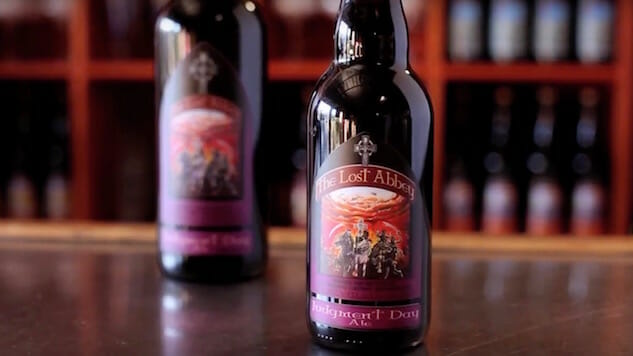7 Underrated Beers from Major Breweries
Photo via Lost Abbey
Broadly speaking, the majority of breweries are known for two types of beer in their lineups: the year-rounder that keeps the lights on and feels as much at home in the downtown hipster bar as it does next to the three macro taps at your local dive, and the special projects made possible by that beer.
But then you have the beers that get lost in the shuffle. Whether it’s a year-round offering overshadowed by the brewery’s flagship, or an un-hyped seasonal that sells just enough to justify production, every brewery has that one beer that sits on the shelf, and makes you go “Oh yeah…that.” These are those underrated beers.
Sierra Nevada Kellerweiss

Sierra Nevada occupies a peculiar spot in the current craft beer zeitgeist: firmly rooted in the ‘80s-‘90s origins of the original craft beer boom, they exist primarily as a safe spot, a touchstone for beer drinkers crippled by indecision at the local bottle shop. And though they do exhibit a willingness, inspired by an awareness of the industry’s evolution, to roll out new and experimental offerings, their strength still lies in no-nonsense styles and tempered execution.
Take Kellerweiss. A 4.8% year-rounder, this beer has come and gone for years now with little fanfare, though its continued presence on store shelves and tap lines is an indication of its stalwart, if bookish, quality. Modeled on the classic German hefeweizen, its nearest old-world approximation is Ayinger Brau-Weisse: a light-bodied, summer-bright wheat beer with the typical clove, banana, and bubblegum yeast notes.
Like Brau-Weisse, Sierra Nevada Kellerweiss is everything you’d want from the style: a cream-of-wheat texture, lemon-vanilla complements, and an alcohol content that encourages more than one serving. Start caring about this beer, now.
Rochefort 8

I know Rochefort, you know Rochefort. We love Rochefort. As recently as 15 years ago, this tiny Trappist brewery from the eponymous Belgian town carried the same phantom mystique that Westvleteren does today. Due, however, to increased availability and distribution, they are today as at home on the reclaimed-wood shelves of your local independent bottle shop as they are under the fluorescent hum of a Kroger beer aisle. Thanks, creative writing MFA.
Rochefort 8 was already the odd man out from the brewery’s lineup, thanks mainly to the existence of the majestic Rochefort 10, an 11.3% quad that, honestly, tastes like scorched Coca-Cola when young, but evolves into sublimity after a few years. 8 languished, and still languishes in the shadow of 10, which sounds like a lyric from a Rush album.
Rochefort 8 is, however, my favorite beer from the brewery, and arguably its best. Why? For one, while you can age it for years and get increased returns on flavor, it is ready to drink right off the bat. For another, it’s just a downright damned fine beer: rich and toffee-laden, with fig, prune, raisin, and slight chocolate flavors, it’s the quad style embodied.
Surly Bitter Brewer

I’m cheating here. Bitter Brewer is no longer in production at Surly, and the world is worse off for it. Still, I think I understand why: it was such a miasma of styles and influences—a bitter by name, American pale ale in execution—that it probably became a perfect pain in the ass to market.
So what is it, exactly? Bitter Brewer is essentially a session IPA, brewed with oats, plus Glacier and Warrior hops. Its official classification is of a British bitter, but that’s like calling Prince a “singer,” so whatever. Like Prince, however, this beer is freaking awesome and impossible to pin down. Though it does hint at its namesake through a distinct orange marmalade-like hop character, there is an aggressiveness about the hop profile that eschews subtlety and propels the beer into another category altogether. The malt hints at honey biscuits and oyster crackers.
Seriously. Surly? Stop Twitter-trolling us with Leinenkugel and use that time to brew this beer again.
-

-

-

-

-

-

-

-

-

-

-

-

-

-

-

-

-

-

-

-

-

-

-

-

-

-

-

-

-

-

-

-

-

-

-

-

-

-

-

-












































